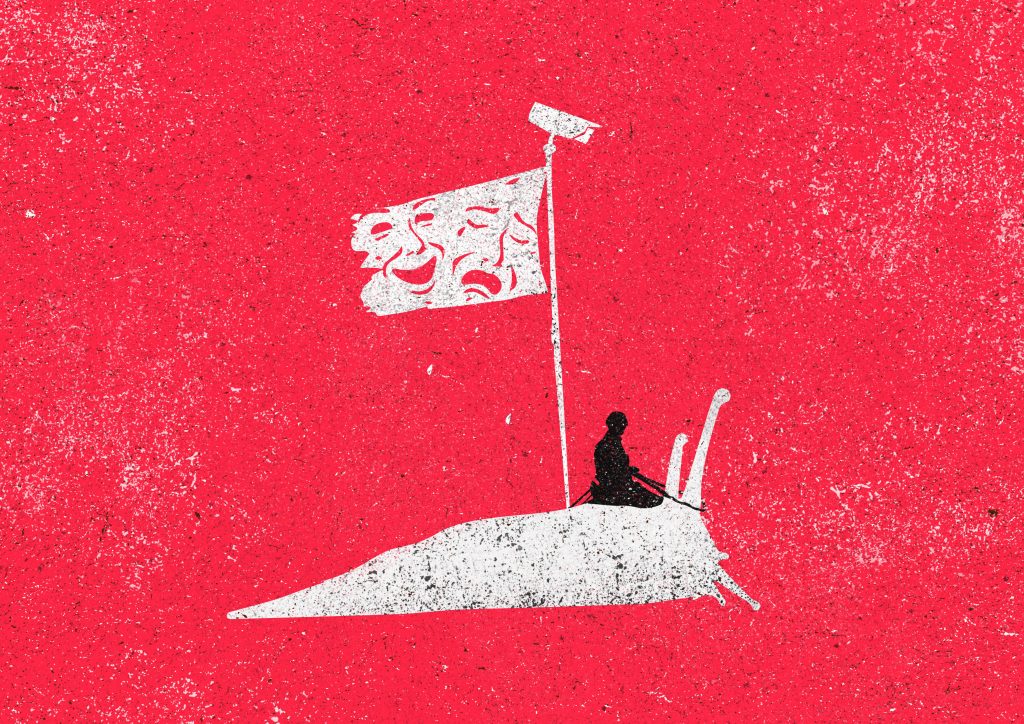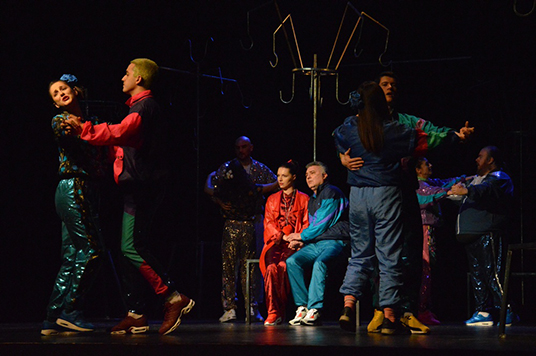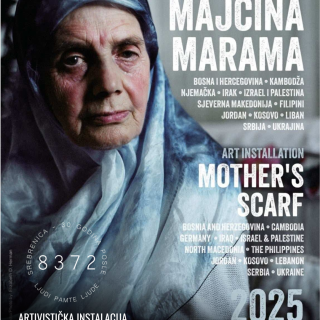“Normally there are people in this country who want peace. Normally there are those who want victory, they want neither war nor death. But nobody will win, they will only die.”
Borka Pavićević
At the beginning of 2018, the international media informed that a group of artists in Serbia were preparing a musical about Milošević, entitled “Lift: Slobodan shou”. Both media and the public were very curious. And the information said the show would be performed in Gračanica/Graçanicë, a town inhabited mainly by a Serbian population, not far from the capital of Kosovo, Prishtina.
Before speaking about the show, it is important to speak about the theater producing it. The show was being staged by the People’s Theater of Prishtina (Narodno Pozoriste Pristina/ Народно позориште Приштина), ‘temporarily displaced in Belgrade’, as it is referred to officially in Serbia! This is a theater that carries out artistic and administrative activities in Belgrade but performs in Kosovo from time to time, in localities inhabited by the Serbs. Recently it was said, at least officially, that they had moved to Gračanica/Graçanicë.

Now, let’s delve further into the past. The People’s Theater of the Province was built in Prishtina in 1946, right after World War Two. It was initially conceived as a cultural center, of the kind that at that time began sprouting all over former Yugoslavia, to become in 1948 the People’s Theater of the Province. At that time, Kosovo was an autonomous social province of Serbia, within the Social Federation of Yugoslavia and the theater had a significant social and cultural weight. Throughout its over 70-years old history the theater changed its name several times. Since 2008, when Kosovo proclaimed its independence, it was officially named the National Theater of Kosovo. The frequent name changes constitute a certain chronicle of political changes related to the political status of Kosovo.
This theater had two actor ensembles: the Albanian drama ensemble and the Serbian drama one. However, despite the usual tensions that exist in nearly every theater, it is said that until 1990 there was a certain harmony among the Albanian and Serbian artists and staff. Due to a greater number of Albanian audience in Prishtina, the Albanian drama repertoire had a central place in this theater, even numerically, and usually directors were Albanian.
However, the functioning of this theater was disrupted during the ‘90s, a time when it was forcefully taken under the administration of people who were loyal to Milošević. The new Serbian administration sent away from their jobs the majority of Albanian actors and a good part of the technical and administrative staff, including the Albanian director. “The violent measures”, as such usurping of public institutions were called at that time were being implemented across Kosovo. Hundreds and thousands of theater, factory, hospital, administration employees etc., were left unemployed.
Therefore, after the People’s Theater of the province was ‘taken by the Serbs’, as it was said back then, it became an almost hated institution for the Albanians, who then hesitated to watch the plays there. The new Serbian administration organized one or two shows in Albanian every season just to ‘prove’ that it was open to the Albanian public too, and was not on any project that would breach their cultural rights. But in reality, some Albanian plays at the beginning of the 90s were either prohibited or forcefully taken out of the repertoire! Thus, the Albanian creators were shown the new direction the theater had now taken: to serve the hegemonic Albanian politics and become part of the general machinery that aimed the national purification of Kosovo, from, as they called it, Albanian domination.
During the war in Kosovo, the majority of Albanian artists had to leave Kosovo and stay as refugees in Macedonia and Albanian. Meanwhile, the artists of Serbian drama at this theater continued their work without displaying the slightest solidarity with the Albanian artists who were forced to leave Kosovo because of the war and because they were being hunted by the Serbian police and military that considered them “an enemy target”, just like any other Albanian in Kosovo.
After the end of the war in Kosovo in 1999, the Serbian drama of this theater was dissolved, whereas the Serbian artists and staff left Kosovo to go to Serbia, just like the majority of the Serbian population living in Prishtina. On the other hand, the artists and administration of the Albanian drama returned from the refugee camps and resumed work, now under new circumstances but also facing new challenges, altogether different from the pre-war ones. Now, that theater stages shows only in Albanian language.

Several years after the end of the war in Kosovo, the Government of Serbia established the People’s Theater of Prishtina (Narodno Pozoriste Pristina/ Народно позориште Приштина), a parallel theater, which, according to them, is a continuation of the pre-war theater in Prishtina. This theater was established as an attempt to create continuity of the ‘Serbian institutions’ that existed in Kosovo before the war, in “their then-province”. Their goal, at least symbolically, is for these institutions (i.e., of this theater displaced temporarily in Belgrade), to one day return and be reinstated in Kosovo.
Let us make it clear from the beginning: the existence of a theater is almost always an act of emancipation. However, it should be said that this theater, established by the Serbian Government as such was not established to serve the Serbian public in either Serbia or Kosovo. Indeed, it was not even established as a house to honor those Serbian artists who once upon a time lived and created in Prishtina, at the theater once called The People’s Theater of Kosovo. No, it was established for entirely ideological reasons; to serve the interests of hegemonic appetites of the Government of Serbian and their efforts to demonstrate “their ownership over Kosovo”. Further, through its ‘establishment decree’ and its programmatic policies has proved to be in service of politics. More specifically, in service of the Government of Serbia, which has continued even after the war with the same hegemonic politics against Kosovo, just like the ones in the ‘90s.
And now, when we have shown only a little from a not-so-glorious, even compromising history, of this parallel Serbian theater that operates in Belgrade, let us turn to the show “LIFT: Slobodan Shou”, which performed in Gračanica/Graçanicë, Kosovo, on 6 March 2018. The show is about Slobodan Milošević and his relations with his family during the NATO bombing. Let us mention here the fact that this show is being put on stage some 20 years after the war in Kosovo and 15 years after the death of Milošević. It premiered at the Cultural Center in Gračanica/Graçanicë and generated great interest of the international media, which were naturally curious to see how a Serbian theater cast would deal with the character of the “Butcher of the Balkans”.
To me, but too many others that night who saw the premiere, it was disappointing to see how artists of our region, despite the ‘90s wars in former Yugoslavia, have not managed to detach themselves from the shell of nationalistic propaganda and war-mongering ideology.
In this respect, the statements by director Nenad Todorović and playwright Jelena Bogavac before the premiere, were, to say, optimistic. They claimed a critical approach towards Milošević and his legacy of wars and crimes.
“Our people could never judge him. This is our version of the Serbian Hague,” said director Nenad Todorović in an interview. However, in reality, the show conveyed an entirely different thing, different visions that relativize Milošević’s crimes. It was a desperate attempt to lay elsewhere the blame for the crimes of Milošević and the Serbian Government of that time.
The show mainly deals with some ephemerous problems of the Milošević family. Whereas, when it talks about the real war problems, it deals with those through the cliché lens of the Serbian nationalism; i.e., a lens that reduces almost entirely the responsibility of Milošević, while projecting the blame for the wars in the ‘90s onto the “Great Powers’ and the ‘international media propaganda’. Serbs are portrayed as they main victims on whom the great power unleash bombs ‘disregarding the international conventions.’ The show makes no mention of non-Serb victims, nothing is said about the sufferings of the others. Consequently, there is no responsibility on the side of the Serbs. “LIFT: Slobodan shou” is a distorted reading of the history of the ‘90s, and we would say, an intentional distortion.
Milošević in this show is that “angel at the corner”, who is ashamed and unable to change the course of fate, the course of history, and the course of “what is meant to be”. He is a ‘small player’ who cannot act and can do nothing to stop the wars of that time. His responsibility equals zero.
This attempt to revise history, the rehabilitate his criminal past is both anti-historic and antihuman. Milošević’s role is well documented. He is responsible for the murder of over 100,000 people, and responsible for the sufferings of tens of millions of refugees displaced by violence from Bosnia, to Serbia, Kosovo, and Croatia.
In another context, which we can very well use here too, the Serbian writer and journalist Tomislav Marković explains well the attempts of several Serbian artists to see “the other side of Milošević’s character”, namely, their attempt to reduce him to a ‘man of flesh and blood’. He writes: “When we deal with Slobodan Milošević, the head of the biggest killing machine in the region, the biggest criminal among Serbian rulers, the man who started three wars, caused the death of thousands of people and the displacement of several other millions, who destroyed his country and brought it to the brink of apocalyptic destruction everything that came across him – and thus he is insignificant as an individual but exclusively as the head of the mass murder system, as the driving force of the death industry. Milošević is neither Raskolnikov, nor Meursault so that we deal with his individual psychology or his relations with his neighbors.”
It is obvious that the official Serbian politics after the ‘90s aims to negotiate the role and responsibility of Milošević and Serbian state. In this respect, there is an attempt to fabricate ‘parallel’ facts because of the belief in the quote by Danilo Kiš in “A Tomb for Boris Davidovich”, which says that “facts are those which we agree upon to be such.’ So, the Serbian politics but also a segment of the intellectual elite are attempting to find co-negotiators of facts and this attempt for negotiation comes in different forms, in this case in the form of a theater show.
Jeton Neziraj (1977), playwriter, was the Artistic Director of the National Theater of Kosovo. He is currently the Director of the Multimedia Center in Prishtina, an association that deals with literature and theater. He has written over 20 plays, which have been staged in Kosovo and abroad, in Europe and the US, and have also been translated and published in over 15 other languages.
Part II will be published on Thursday 23 February 2023. This article has been produced as part of a cooperation between Sbunker and forumZFD Kosovo




